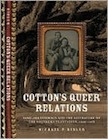 Cotton’s Queer Relations: Same-Sex Intimacy and the Literature of the Southern Plantation, 1936-1968
Cotton’s Queer Relations: Same-Sex Intimacy and the Literature of the Southern Plantation, 1936-1968
by Michael P. Bibler
University of Virginia Press. 298 pages, $22.50
WITH THIS BOOK, Michael P. Bibler proposes to show that several works of 20th-century American fiction set on what he calls the Southern “meta-plantation” use same-sex relationships to undermine “the vertical system of paternalistic and patriarchal hierarchies that constitutes the core social structure of every individual plantation.” He breaks this down into examinations of white male-male relations in William Faulkner’s Absalom, Absalom and in Tennessee Williams’s Cat on a Hot Tin Roof, plus same-sex female relations in Lillian Hellman’s two plays, The Little Foxes and Another Part of the Forest, Katherine Anne Porter’s The Old Order, and Margaret Walker’s Jubilee. He also examines relations between African-American men in William Styron’s The Confessions of Nat Turner and in Arna Bontemps’s Black Thunder.
Some of the same-sex relationships are in fact homosexual; others rise only to what Leo Bersani called “homo-ness”: “the effect produced when sexual sameness supersedes all other factors of identity to establish, however provisionally, an egalitarian social bond between individuals.” Sometimes the homosexuality is only a brief episode that resembles simple adolescent experimentation. Though it would have been less likely to sell books, the subtitle of this study might therefore more accurately have been something like: “Social and political lessons that close relations between individuals of the same sex taught those trapped in paternalistic and patriarchal hierarchies.”
One such lesson involves Nat Turner and his friend and fellow slave Willis in the Styron novel. As part of building the fortitude he believes he will need to lead a slave revolt, Turner denies himself all sexual contact with women. But one day while fishing with Willis, the two men end up masturbating each other. “And then for a long moment as if set free into another land we did with our hands together what, before, I had done alone. Never had I known that human flesh could be so sweet.” From this one episode, indeed this one sentence, Bibler argues that homosexuality, or at least a homosexual act, reveals to Turner the possibility of a non-hierarchical, egalitarian social structure: “Nat comes to recognize a new system of relations that isn’t governed by the laws of domination, force, violence, inequality, and ownership that govern the ‘land’ of Virginia in which he actually lives. The momentary shift into freedom thus reveals the socially revolutionary potential of homosexuality. … Styron clearly situates this transcendent moment as Nat’s most empowering inspiration for both the idea and the real possibility of slave revolt.” Bibler repeats variations on this assertion for the rest of that chapter.
This idea is certainly an appealing one. Bibler does not, however, provide sufficient proof that the text itself suggests this conclusion. It certainly says that after he ejaculated Turner “felt free into another land,” as most of us, gay or otherwise, do for at least a moment after orgasm. But nothing in that passage or any other that Bibler cites shows that having sex with another man inspires in Turner a vision of a society in which all men are equal. He asserts repeatedly that “Nat’s experience of the power of homo-ness is vital to the revolution he plots later in the novel” and that this “homo-ness offers a new sense of an egalitarian society opposed to the hierarchical structure of the plantation,” but he doesn’t show that the novel itself proposes this thesis.
I had the same problem with some of the other essays, notably the one on Cat on a Hot Tin Roof. Williams’ play mentions briefly that Big Daddy’s plantation was originally owned by two evidently single men, Jack Straw and Peter Ochello. Although the text says almost nothing about them, Bibler asserts not only that they were a gay couple, which Big Daddy at one point does seem to imply, but that their relationship was “unquestioning, unconditional, totally reciprocal, and unusually symmetrical.” He provides no textual support for this assertion, however.
This book raises interesting questions regarding important literary works and offers relevant readings that appealed to me as a gay man. But many of its most interesting assertions are not adequately substantiated with reference to the actual texts under discussion.
________________________________________________________
Richard M. Berrong is the author of In Love with a Handsome Sailor, a gay reading of the novels of French author Pierre Loti.





